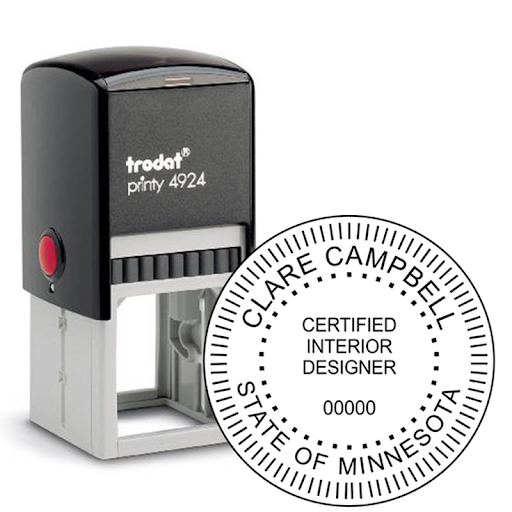A Glimpse into Interior Design Licensing Legislation | Does Your State Require a License to Practice Interior Design?
©️ Dakota Design Company 2017-2025 | All rights reserved. This content may not be reproduced, distributed, or used without permission.
Written March 2023 | Updated August 2025
You may have heard issues related to interior designer licensing or certification (read more about interior design certifications here), and it can all be a bit confusing. Additionally, licensing legislation for various occupations (including interior design) happens at the state level so the picture is slightly different in every state (plus the Canadian provinces). And, things are changing all the time with new interior design legislation being proposed (and sometimes repealed) every year. And, in some respects, this issue of interior design regulation is much different for those who work on commercial building projects than it is for those who work on residential projects.
In this post, we offer an overview of the current state of interior design legislation. To verify the legislative picture where you live and work, it is always best to check the professional licensing and registration website for interior design in your state. To do that, Google “interior design licensing in + your state”.
💌 Want my best insights and strategies delivered weekly? Join The Weekly Install® — it’s free. Sign up here.
In most states, interior design is not a licensed profession in the same way that medicine or aviation are. As with driving a car, if licensing is required, it is illegal to perform that function unless you possess a current license. It would be illegal to practice medicine or fly a plane without a valid and current license to do so. Many other occupations, including nursing, hairstyling, architecture, pharmacy, and law require licensing, but again, requirements can vary by state.
In general, if a professional service will affect the health, safety, or welfare of the public, that profession will likely have a licensing requirement.
Many argue that the work of interior designers can definitely impact the health, safety, and welfare of their clients. Interior designers have to ensure they are specifying materials that are fire retardant, slip resistant, or that lack harmful off-gasses. Interior designers have to be mindful of whether the materials they specify have the potential for recyclability or reuse so as not to clog landfills. And interior designers need to know the building codes and fire safety requirements to ensure the spaces where clients live and work are optimally safe. Even the building codes for single-family homes are quite complex and require a deep level of familiarity.
📖 Need to tighten up your knowledge on codes? Be sure to grab our Residential Building Codes Handbook and cheat sheet here.
However, many feel that interior design is a profession that relies more on aesthetics and specialized talent than on technical execution, and therefore does not adequately meet the threshold of an occupation that requires a license in order to practice.
Whether you are for or against interior design licensing (or you live in one of the few states that requires licensure to practice interior design), there is one critical detail which affects interior design regulation in an important way.
Single family homes (and sometimes duplexes) are a building type that is exempt from some of the regulations that pertain to all commercial buildings. And the building codes and other standards that exist for commercial buildings mostly do not apply to single family residences.
Most states have statutes that make single family housing exempt from the requirement that licensed design professionals design them, such as this statute from Florida that says certain building types do not require a licensed architect to design them.
Check here to see what the requirements are for your state regarding licensed architects and other licensed design professionals regarding single family homes.
In most states, home builders — not architects — develop plans and specs for houses. Similarly, licensed structural, electrical, and mechanical engineers are most certainly required for the design of any commercial building. Not so for a home, where a licensed electrician or plumbing contractor will do.
💌 Want my best insights and strategies delivered weekly? Join The Weekly Install® — it’s free. Sign up here.
So, as single family homes are an exempt building type (exempt from the requirement for licensed design professionals), similarly, anywhere interior design licensing exists — mandating a license before the ability to practice — this would mostly apply only to commercial interior designers.
In what states IS IT required to have a license in order to practice interior design?
Currently only in Nevada, Louisiana, and Washington DC.
These jurisdictions have what is called “Practice Act” legislation – meaning, in order to practice interior design, a license is required, as with medicine and aviation.
However, as single-family homes are an exempt building type, the work of residential designers or kitchen and bath designers is not affected in the same way as commercial designers are in the requirement for licensing.
🗺️ Again, check here for state-by-state licensing requirements for single-family homes.
Why only two states and DC?
Many people strongly oppose interior design licensing and have historically thwarted attempts by other states to pass “Practice Acts.” Members of the American Institute of Architects (AIA) and the National Kitchen and Bath Association (NKBA) have long felt that interior design licensing would infringe on their ability to practice in their respective fields.
No matter which side of this issue you are on, it’s important to understand this complex picture.
Still with me? Let’s continue…..
The interior design legislation that many states do have in place is what is called a “Title Act” which mandates the use of a specific title: Registered Interior Designer or Certified Interior Designer, or something similar depending on the state’s choice of title.
In these states, anyone is free to practice interior design (commercial or residential), and anyone can call themselves an interior designer. But only those designers who have met certain criteria (passing the NCIDQ exam and completing various other requirements mandated by that state) can call themselves the title utilized by that state: Registered Interior Designer or Certified Interior Designer, or something similar.
With this title designation, those qualifying designers are required to renew their title registration every year or two by paying a registration fee and showing completion of required continuing education. Each year, another state or two has been able to pass “Title Act” legislation, giving those designers who have earned that credential special recognition, so the picture across the country is constantly changing.
Can Interior Designers Stamp Construction Documents?
Another thing that has been changing in interior design legislation in recent years is legislation that gives qualified interior designers the ability to stamp and sign (sometimes called stamp and seal) construction documents that are submitted to building departments for the purposes of applying for a building permit. This ability to “stamp and seal” documents is called interior design permitting privileges, and typically has the same qualifying requirements as those for the “Title Act”, including passing the NCIDQ exam.
Typically, a licensed architect or licensed engineer must vouch for the accuracy and integrity of construction documents by officially stamping and signing them. But, in the case where the scope of work includes interior work or non-load bearing construction, interior designers in certain states can perform this function.
This provides important recognition for the interior design profession, as it acknowledges the high level of expertise interior designers have in their area of practice. A designer working on a project for the reconfiguration of several rooms, and the installation of materials and finishes will no longer have to seek out (and pay!!) an architect—who may have had no involvement in the project —to add his or her stamp and signature to the drawings prior to applying for a permit.
Again, within residential interior design, the picture is a bit complex, as—for single-family home construction—that professional stamp by a licensed design professional is not required for drawings for residential buildings in many states.
But, to even further confuse things, while a STATE may not require a stamp from a licensed architect, a COUNTY may. (As is the case in the county where I live, in Illinois.) <— so, always familiarize yourself with your the laws in your jurisdiction.
Regardless, the important thing to understand is that in many ways, the professional contribution of interior designers has historically not received the same recognition, or has not been held in the same high regard as architect counterparts. But thanks to the ongoing advocacy efforts of many interior designers across the country, that picture is changing for the better, and interior designers are being given the acknowledgment that significant professional expertise is required to perform interior design services (which is SO much more than just fluffing pillows).
Interior Design Licensing by State
You can check out the interior design licensing laws by state on the IIDA map here (updated March 2024) or the CIDQ map here (updated October 2024) for information about each state, including which states have “Practice Acts” (mandating who can practice interior design), “Title Acts” (mandating who can use specific titles such as Registered Interior Design or Certified Interior Designer), or permitting privileges (the ability to stamp and seal construction documents) for qualified interior designers.
Looking for more? Keep reading:













